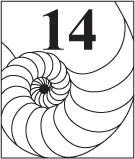COMBINATORIAL MODELS I
Nothing ever becomes real till it is experienced; even a
proverb is no proverb to you till your life has illustrated it.
–John Keats
In Chapters 4 and 5, we studied several interesting applications of the Fibonacci and Lucas family to combinatorics, including the theory of partitioning. In this chapter, we will present additional applications to combinatorics.
In Section 4.2, we briefly studied compositions of positive integers n with summands 1 and 2. We found that the number of distinct compositions ![]() of n is
of n is ![]() ; see Table 14.1.
; see Table 14.1.
| n | Compositions | |
| 1 | 1 | 1 |
| 2 | 1 + 1, 2 | 2 |
| 3 | 1 + 1 + 1, 1 + 2, 2 + 1 | 3 |
| 4 | 1 + 1 + 1 + 1, 1 + 1 + 2, 1 + 2 + 1, 2 + 1 + 1, 2 + 2 | 5 |
| 5 | 1 + 1 + 1 + 1 + 1, 1 + 1 + 1 + 2, 1 + 1 + 2 + 1, 1 + 2 + 1 + 1, | 8 |
| 2 + 1 + 1 + 1, 1 + 2 + 2, 2 + 1 + 2, 2 + 2 + 1 | ||
14.1 A FIBONACCI TILING MODEL
Theorem 4.1 has a spectacular combinatorial interpretation. To see this, suppose we would like to tile a board (an array of n unit squares) ...
Get Fibonacci and Lucas Numbers with Applications, Volume 1, 2nd Edition now with the O’Reilly learning platform.
O’Reilly members experience books, live events, courses curated by job role, and more from O’Reilly and nearly 200 top publishers.


